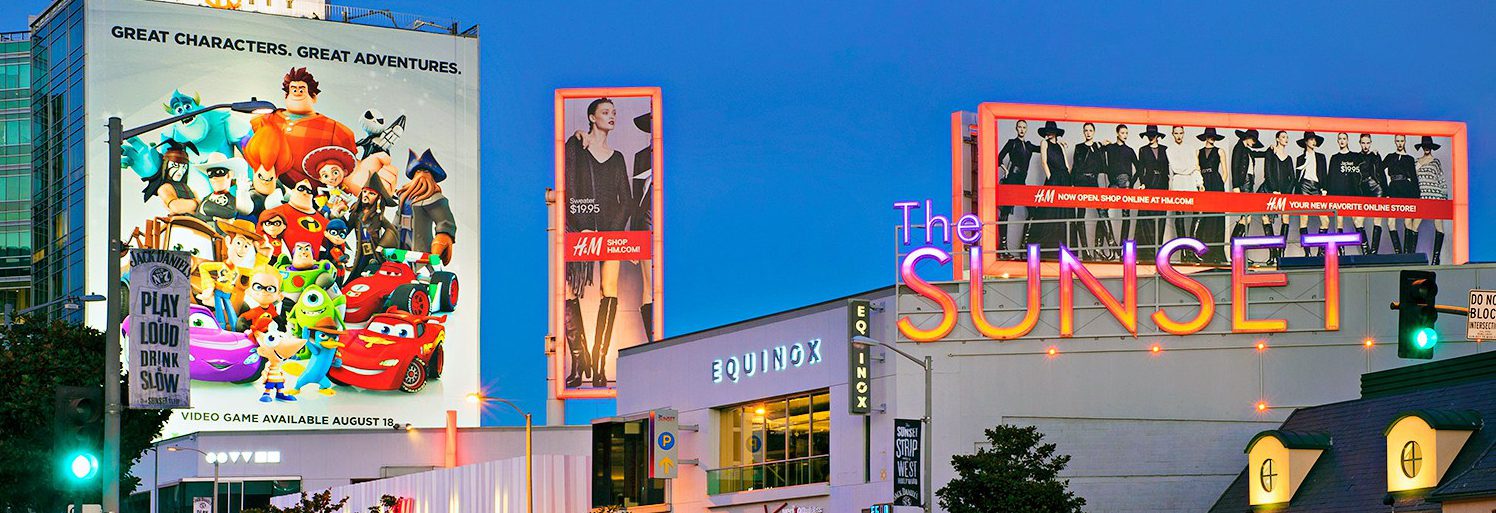
The billboards on Sunset Boulevard in my hometown of L.A. have always been prime real estate. From the hand-painted signs of yesteryear to today’s blacklight, multidimensional flights of fancy, people want their films, albums, and faces up there. And they will pay a premium for it, even after digital and social media have changed almost every other part of advertising and promotion.
As Sunset Boulevard and its signage rise, so rises the world. It’s no coincidence that what plays well here also kills it in other markets around the country. Everyone went digital — and digital may still make up a generous half or more of marketing budgets — but there’s a backlash underway. Digital ads are cost-efficient and measurably effective, sure, but that backlash is fueling the outdoor renaissance, as Netflix’s recent $300 million bid to buy Regency Outdoor proves.
As other traditional media have seen consistent, sometimes double-digit declines in ad revenue, out-of-home advertising is seeing modest but real growth. In its recent report, Magna Global observed an increase of $7.9 million in outdoor ad revenue in 2017, growth predicted to double roughly in 2018. This demonstrates a curious resilience in the face of an ongoing collapse of ads on linear radio, TV, and in print.
This seems strange when you consider that the billboard is the oversized modern descendant of some of the oldest forms of advertising, the carved or painted sign board, the painting on the wall near the market, the broadside pasted up for passersby. It’s a dinosaur that’s not only survived but thrived. But here’s the thing: its role has changed completely in the strange world created by social media and its culture of artfully curated vanity.
Billboards used to be a lot like their handcrafted ancestors, a way to shout at a certain crowd of people in very particular markets. Outdoor campaigns unfolded accordingly, buying billboards all over the place to reach the requisite audience.
Now, things are different. A single billboard makes a statement because it’s reflected in a thousand posts and impressions across the internet. Increasingly, people just want to buy one billboard for its social media potential, one reason Sunset remains red hot. Or they may buy a single billboard in the middle of nowhere as part of a bigger content creation gesture, a video or activation.
Why do people want to spend carefully managed ad and marketing dollars on a giant sign in a single city? Because billboards (and their more punk-rock cousin wildposting) get shared all over social media. You can take a selfie with these ads, and it feels cool. You just can’t do that with a radio or television spot. It’s the only tangible form of advertising left that still makes an impact.
Billboards and walls of wheat-pasted flyers are tangible, yet easily translate into the intangible. They scream, “Hey, I made it!” in a way that strokes the ego like a star on the Walk of Fame. Outdoor ads are perfectly tailored to the age of personal branding.
Moreover, digital ad prices are growing rapidly, while billboard costs remain relatively stable. A study by marketing-analytics company AdStage found that in the first half of 2017, the average cost per 1,000 impressions on Facebook increased 171%, and the average cost per click increased 136%. Now, these costs are highly cyclical, but generally speaking, billboard prices are not facing this kind of upward price pressure.
Billboards have also become great anchors for innovative digital campaigns and fun activations, the kind of marketing that makes fans go out of their way to engage with an ad. They can turn into easter egg hunts, when something is hidden at the billboard site or certain digital features only work when you’re in the vicinity of the ad. They inspire contests, such as the first person to take a picture from this location wins free concert tickets. But most importantly for marketers, they inspire selfies and other tagged posts, making a single billboard purchase go a long way in standing out in overloaded feeds and short attention spans.
Originally posted to The Marketing Insider.
Published: June 8, 2018